| More Cowboy Heros
Duncan Renaldo from Wikipedia
| Renault Renaldo Duncan (April 23, 1904 – September 3,
1980), better known as Duncan Renaldo, was a Romanian-born American actor
best remembered for his portrayal of The Cisco Kid in films and on the
1950-1956 American TV series, The Cisco Kid.
Early years
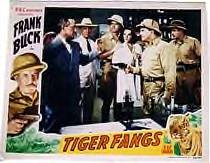 . .
Movie poster for Tiger Fangs, left
to right: Arno Frey,
J. Farrell MacDonald, Howard Banks,
June Duprez, Frank Buck,
Duncan Renaldo |
Renaldo told some interviewers that he actually did not
know where he was born. Various sources claim that he was born in Oancea,
Gala?i County, Romania as Vasile Dumitru V. Couyanos or Basil Couyanos.
Renaldo apparently never knew his biological parents and was raised in
several European countries. His birthplace has been generally stated as
Romania and he said his first childhood memories were in Romania.
He emigrated to America in the 1920s. Failing to support
himself as a portrait painter, he tried producing short films. He eventually
took up acting and signed with MGM in 1928 where he worked in at least
two major films, The Bridge of San Luis Rey and Trader Horn. The latter
film was shot on location in Africa and is notorious for adventures that
rivaled the source book's and film's plot of a "great white hunter" and
a white blonde jungle queen, |
the lost daughter of a missionary. One crew member was taken
by a crocodile and another killed by a charging rhino. Many crew and stars
were stricken with malaria but Renaldo told one interviewer in 1971 that
he never contracted the parasite because he took a hunter's advice to "race
the blood" with a shot of whiskey in the morning and another at dusk. |
.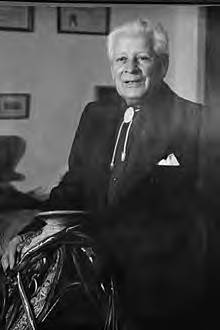
Duncan Renaldo, in his trophy room
in Goleta, Ca., circa 1973-74.
Photo by Gene Snead. |
In 1934, he was arrested for illegal entry into the United
States, but eventually was pardoned by President Franklin Roosevelt and
returned to acting. He found minor roles at Republic Studios and other
Poverty Row studios until he convinced Republic head Herbert Yates in 1939
to introduce a Latin cowboy into The Three Mesquiteers series. The character
only lasted a year, though, and Renaldo was back to minor roles in B-films,
for example Tiger Fangs (1943). Renaldo did play some roles in mainstream
films as well, including in Spawn of the North (1938) with George Raft,
Henry Fonda and John Barrymore; and For Whom the Bell Tolls with Gary Cooper
and Ingrid Bergman. He was also a producer, writer and director.
| Television star
In the late 1940s, Renaldo starred in several Hollywood
Westerns as The Cisco Kid, and in 1950, he began playing the role in a
popular television series that ran until 1956. In the age of black-and-white
television, the show was filmed in color. As Cisco, Renaldo roamed the
Old West on a black-and-white horse named Diablo, accompanied by his constant
companion, Pancho, played by Leo Carrillo, who was 24 years Renaldo's senior.
The Cisco Kid always helped where needed, and unlike most Western heroes,
rarely killed anyone.
Renaldo illustrated a book of poetry by Moreton B. Price
titled Drifter's Dreams. His illustrations are ink sketches of idyllic
scenes, primarily seascapes and landscapes. He also painted in oils. Two
of his large paintings of members of the Maasai tribe whom he met in Kenya
while filming "Trader Horn" were prominently displayed in his Santa Barbara
home in 1971.
Death
Renaldo died of lung cancer in 1980, aged 76, in Goleta,
California. His interment took place in Calvary Cemetery in Santa Barbara,
California. |
.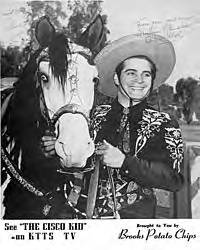
Renaldo as
The Cisco Kid with Diablo |
|
Buck Jones from Wikipedia
| Born, December 12, 1891, Vincennes, Indiana – November
30, 1942, Boston, Massachusetts
Buck Jones was an American motion picture star of the
1920s, 1930s, and 1940s, best known for his work starring in many popular
western movies. In his early film appearances, he was billed as Charles
Jones.
Early life, military service
Charles Frederick Gebhart was born on the outskirts of
Vincennes, Indiana on December 12, 1891. (Some sources erroneously indicate
December 4, 1889, but Jones's marriage license and his military records
confirm the 1891 date.) In 1907, Jones joined the US Army a month after
his sixteenth birthday: his mother had signed a consent form that gave
his age as eighteen. He was assigned to Troop G, 6th Cavalry Regiment,
and was deployed to the Philippine islands in October, 1907, where he served
in combat and was wounded during the Moro Rebellion. Upon his return to
the U.S. in December, 1909, he was honorably discharged at Fort McDowell,
California.
Jones had an affection for racecars and the racing industry,
and became close friends with early racecar driver Harry Stillman. Through
his association with Stillman, he began working extensively as a test driver
for the Marmon Motor Car Company. Yet by October 1910, he had re-enlisted
in the US Army. Because he wanted to learn to fly, he requested a transfer
to the Aeronautical Division, U.S. Signal Corps in 1913, without knowing
that only an officer could become a pilot. He received his second honorable
discharge from the Army in October 1913.
|
.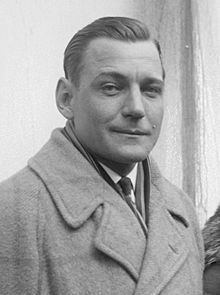
Jones in 1926 |
Cowboy, stuntman, beginning of film career
| Following his military service, he began working as a
cowboy on the 101 Ranch near Bliss, Oklahoma. While attending equestrian
shows he met Odille "Dell" Osborne, who rode horses professionally. The
two became involved, and married in 1915. Both had very little money, so
the producers of a Wild West Show they were working on at the time offered
to allow them to marry in an actual show performance, in public, which
they accepted.
While in Los Angeles, and with his wife pregnant, Jones
decided to leave the cowboy life behind and get a job in the film industry.
He was hired by Universal Pictures for $5 per day as a bit player and stuntman.
He later worked for Canyon Pictures, then Fox Film Corporation, eventually
earning $40 per week as a stuntman. With Fox his salary increased to $150
per week, and company executive William Fox decided to use him as a backup
to Tom Mix. This led to his first starring role, The Last Straw, released
in 1920.
Stardom
In 1925 Jones made three films with the then very young
Carole Lombard. Jones had more than 160 film credits to his name,and by
the 1920s, Jones joined Hoot Gibson, Tom Mix, and Ken Maynard as the top
cowboy actors of the day. By 1928 he started his own company, but his independently
produced film The Big Hop (a non-Western) failed. He then organized a touring
Wild West show, with himself as a featured attraction, but this expensive
venture also failed due to the faltering economy of late 1929.
With the new talking pictures replacing silent films as
a national pastime, outdoor Westerns fell out of favor briefly. The major
studios weren't interested in hiring Buck Jones. He signed with the then-humble
Columbia Pictures, starring in Westerns for $300 a week, a fraction of
his top salary in the silent-film days. His voice, a rugged baritone, recorded
well and the films were very successful, re-establishing him as a major
movie name. During the 1930s he starred in Western features and serials
for Columbia and Universal Pictures. |
.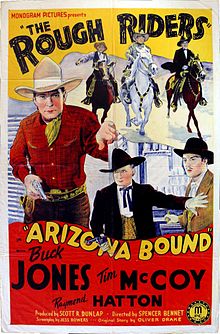
Jones on the poster for the western
Arizona Bound (1941). |
His star waned in the late 1930s when singing cowboys
became the rage and Jones, then in his late forties, was uncomfortably
cast in conventional leading-man roles. He rejoined Columbia in the fall
of 1940, starring in the serial White Eagle (an expansion of his 1932 feature
of the same name). The new serial was a hit, and Jones was again re-established.
His final series of Western features, co-produced by Jones and his friend
Scott R. Dunlap of Monogram Pictures, featured The Rough Riders trio: Buck
Jones, Tim McCoy, and Raymond Hatton.
In 1997, a Golden Palm Star on the Palm Springs, California,
Walk of Stars was dedicated to him.
Merchandising
Buck Jones lent his name and likeness to various product
endorsements, including Post Grape-Nuts Flakes (his radio sponsor), and
Daisy Outdoor Products. Jones was also a consultant for Daisy, which issued
a Daisy "Buck Jones" model pump action air rifle. Incorporating a compass
and a "sundial" into the stock, it was one of Daisy's top-end air rifles,
and sold well for several years.
This led to some confusion decades later with the release
of the well-known holiday film A Christmas Story, based on author Jean
Shepherd's erroneous recollection that the Daisy Red Ryder BB Gun had a
compass and sundial in the stock. The latter gun never did at any time
during its production, save the two specially made examples for the film.
Death
Buck Jones was one of the 492 victims of the 1942 Cocoanut
Grove fire in Boston, Massachusetts, dying two days after the November
28 blaze. For years, legend held that Jones's fatal injuries were the result
of his going back into the burning building to save victims, but it is
now known that he was trapped in the fire.
Family
Buck Jones's daughter, Maxine Jones (born 1918) was married
to Noah Beery, Jr. from 1940 to 1966.
References in popular media
On his album When I Was a Kid, Bill Cosby has a routine
called "Buck Jones," in which he talks about seeing Buck Jones movies as
a kid. He says that Buck Jones had a horse named Silver, like the Lone
Ranger, and that he would chew gum to signal that he was getting angry.
Cosby mentions a specific movie in which a saloon tough picks a fight by
pouring "redeye" liquor over Jones.
|
Gene Autry from Wikipedia
| Orvon Grover Autry (September 29, 1907 – October 2, 1998),
better known as Gene Autry, was an American performer who gained fame as
a singing cowboy on the radio, in movies, and on television for more than
three decades beginning in the early 1930s. Autry was also owner of a television
station, several radio stations in Southern California, and the Los Angeles/California/Anaheim
Angels Major League Baseball team from 1961 to 1997.
From 1934 to 1953, Autry appeared in 93 films and 91 episodes
of The Gene Autry Show television series. During the 1930s and 1940s, he
personified the straight-shooting hero—honest, brave, and true—and profoundly
touched the lives of millions of Americans. Autry was also one of the most
important figures in the history of country music, considered the second
major influential artist of the genre's development after Jimmie Rodgers.
His singing cowboy movies were the first vehicle to carry country music
to a national audience. In addition to his signature song, "Back in the
Saddle Again", Autry is still remembered for his Christmas holiday songs,
"Here Comes Santa Claus", which he wrote, "Frosty the Snowman", and his
biggest hit, "Rudolph the Red-Nosed Reindeer".
Autry is a member of both the Country Music Hall of Fame
and Nashville Songwriters Hall of Fame, and is the only person to be awarded
stars in all five categories on the Hollywood Walk of Fame, for film, television,
music, radio, and live performance. The town of Gene Autry, Oklahoma was
named in his honor. |
.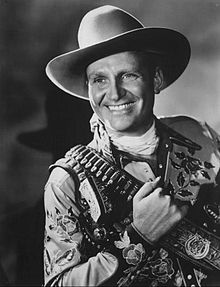
Gene Autry in 1960 |
Early years
Orvon Grover Autry was born September 29, 1907 near Tioga
in Grayson County in north Texas, the grandson of a Methodist preacher.
His parents, Delbert Autry and Elnora Ozment, moved in the 1920s to Ravia
in Johnston County in southern Oklahoma. He worked on his father's ranch
while at school. After leaving high school in 1925, Autry worked as a telegrapher
for the St. Louis–San Francisco Railway. His talent at singing and playing
guitar led to performing at local dances.
Singing career
| While working as a telegrapher, Autry would sing and
accompany himself on the guitar to pass the lonely hours, especially when
he had the midnight shift. One night he got encouragement to sing professionally
from a customer, the famous humorist Will Rogers, who had heard Autry singing.
As soon as he could collect money to travel, he went to
New York. He auditioned for Victor Records, at just about the time (end
of 1928) it became RCA Victor. According to Nathaniel Shilkret, director
of Light Music for Victor at the time, Autry asked to speak to Shilkret
when Autry found that he had been turned down. Shilkret explained to Autry
that he was turned down not because of his voice, but because Victor had
just made contracts with two similar singers. Autry left with a letter
of introduction from Shilkret and the advice to sing on radio to gain experience
and to come back in a year or two. In 1928 Autry was singing on Tulsa’s
radio station KVOO as |
.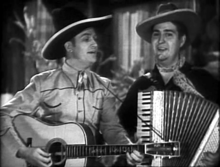
With Smiley Burnette (1934) |
"Oklahoma's Yodeling Cowboy," and the Victor archives shows
an October 9, 1929, entry stating that the vocal duet of Jimmie Long and
Gene Autry with two Hawaiian guitars, directed by L. L. Watson, recorded
“My Dreaming of You” (Matrix 56761) and “My Alabama” (Matrix 56762).
Autry signed a recording deal with Columbia Records in
1929. He worked in Chicago, Illinois, on the WLS-AM radio show National
Barn Dance for four years, and with his own show, where he met singer-songwriter
Smiley Burnette. In his early recording career, Autry covered various genres,
including a labor song, "The Death of Mother Jones" in 1931.
Autry also recorded many "hillbilly"-style records in
1930 and 1931 in New York City, which were certainly different in style
and content from his later recordings. These were much closer in style
to the Prairie Ramblers or Dick Justice, and included the "Do Right, Daddy
Blues" and "Black Bottom Blues," both similar to "Deep Elem Blues." These
late-Prohibition era songs deal with bootlegging, corrupt police, and women
whose occupation was certainly vice. These recordings are generally not
heard today but are available on European import labels, such as JSP Records.
His first hit was in 1932 with "That Silver-Haired Daddy
Of Mine," a duet with fellow railroad man, Jimmy Long, and which Autry
and Long co-wrote, which was parodied by Sesame Street as "That Furry Blue
Mommy Of Mine."
Autry also sang the classic Ray Whitley hit "Back In The
Saddle Again," as well as many Christmas holiday songs, including "Santa
Claus Is Coming to Town," his own composition "Here Comes Santa Claus,"
"Frosty the Snowman," and his biggest hit, "Rudolph the Red-Nosed Reindeer."
He wrote "Here Comes Santa Claus" after being the Grand Marshall of the
1946 Santa Claus Lane Parade (Now the Hollywood Christmas Parade). He heard
all of the spectators watching the parade saying "Here comes Santa Claus!"
virtually handing him the title for his song. He recorded his version of
the song in 1947 and it became an instant classic.
Autry was the original owner of Challenge Records. The
label's biggest hit was "Tequila" by The Champs in 1958, which started
the rock-and-roll instrumental craze of the late 1950s and early 1960s.
He sold the label soon after, but the maroon and later green label has
the "GA" in a shield above the label name.
| Autry made 640 recordings, including more than 300 songs
written or co-written by himself. His records sold more than 100 million
copies and he has more than a dozen gold and platinum records, including
the first record ever certified gold.
Film career
Discovered by film producer Nat Levine in 1934, Autry
and Burnette made their film debut for Mascot Pictures Corp. in In Old
Santa Fe as part of a singing cowboy quartet; he was then given the starring
role by Levine in 1935 in the 12-part serial The Phantom Empire. Shortly
thereafter, Mascot was absorbed by the newly-formed Republic Pictures Corp.
and Autry went along to make a further 44 films up to 1940, all B Westerns
in which he played under his own name, rode his horse, Champion, had Burnette
as his regular sidekick, and had many opportunities to sing in each film.
Pat Buttram was picked by Gene Autry, recently returned from his World
War II service in the Army Air Force, to work with him. Buttram would co-star
with Gene Autry in more than 40 films and in over 100 episodes of Autry's
television show |
.
..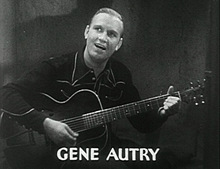
Gene Autry in Oh, Susanna!, 1936 |
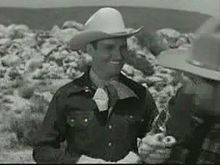 . .
Gene Autry in The Gene Autry Show
episode "The Black Rider", 1950 |
In the Motion Picture Herald Top Ten Money-Making Western
Stars poll Autry was listed every year from 1936 to 1942 and 1946 to 1954
(he was serving in the US Army Air Corps 1943–45), holding first place
1937 to 1942, and second place (after Roy Rogers) 1947 to 1954. He appeared
in the similar Box Office poll from 1936 to 1955, holding first place from
1936 to 1942 and second place (after Rogers) from 1943 to 1952. While these
two polls are really an indication only of the popularity of series stars,
Autry also appeared in the Top Ten Money Makers Poll of all films from
1940 to 1942, His Gene Autry Flying "A" Ranch Rodeo show debuted in 1940.
Gene Autry was the first of the singing cowboys in films,
but was succeeded as the top star by Roy Rogers while Gene Autry served
in the United States Army Air Forces in World War II. Autry briefly returned
to Republic to finish out his contract, which had been suspended for the
duration of his military service and which he had tried to have declared
void after his discharge. He appeared in 1951 in the film Texans Never
Cry, with a role for newcomer Mary Castle. After 1951 he formed his own
production company to make Westerns under his own control, which continued
the 1947 distribution agreement with Columbia Pictures. |
Melody Ranch
Autry purchased the 110 acre Monogram Movie Ranch in 1953,
located in Placerita Canyon near Newhall, California in the northern San
Gabriel Mountains foothills. He renamed it the Melody Ranch after his movie
Melody Ranch. Autry then sold 98 acres of the property, most of the original
ranch. The Western town, adobes, and ranch cabin sets and open land for
location shooting were retained as a movie ranch on 12 acres. A decade
after he purchased Melody Ranch, a brushfire swept through in August 1962,
destroying most of the original standing sets. However, the devastated
landscape did prove useful for productions such as Combat!. A complete
adobe ranch survived at the northeast section of the ranch.
In 1990, after his favorite horse Champion, who lived
in retirement there, died, Autry put the remaining 12 acre ranch up for
sale. It is now known as the Melody Ranch Motion Picture Studio and Melody
Ranch Studios on 22 acres. The ranch has Melody Ranch Museum open year-round;
and one weekend a year the entire ranch is open to the public during the
Cowboy Poetry & Music Festival, another legacy of Autry's multi-talents.
Radio and television career
| From 1940 to 1956, Autry had a huge hit with a weekly
show on CBS Radio, Gene Autry's Melody Ranch. His horse, Champion, also
had a CBS-TV and Mutual radio series, The Adventures of Champion. In response
to his many young radio listeners aspiring to emulate him, Autry created
the Cowboy Code, or Ten Cowboy Commandments. These tenets promoting an
ethical, moral, and patriotic lifestyle that appealed to youth organizations
such as the Boy Scouts, which developed similar doctrines. The Cowboy Code
consisted of rules that were "a natural progression of Gene's philosophies
going back to his first Melody Ranch programs—and early pictures." According
to the code:
1. The Cowboy must never shoot
first, hit a smaller man, or take unfair advantage.
2. He must never go back on
his word, or a trust confided in him.
3. He must always tell the truth.
4. He must be gentle with children,
the elderly, and animals.
5. He must not advocate or possess
racially or religiously intolerant ideas.
6. He must help people in distress.
7. He must be a good worker.
8. He must keep himself clean
in thought, speech, action, and personal habits.
9. He must respect women, parents,
and his nation's laws.
10. The Cowboy is a patriot. |
.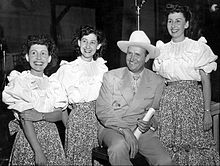
Gene Autry with the Pinafores, who
sang on his weekly radio show, 1948 |
Beginning in 1950, he produced and starred in his own
television show on CBS and made several appearances on ABC-TV's Jubilee
USA in the late 1950s. In 1995 Autry costarred with Charlton Heston, Mickey
Rooney, Deborah Winters and Peter Graves in the Warren Chaney docudrama,
America: A Call to Greatness.
Millitary Career
Autry served as a C-47 Skytrain pilot in the United States
Army Air Corps, with the rank of flight officer in the Air Transport Command
during World War II. He flew dangerous missions over the Himalayas, nicknamed
the Hump, between Burma and China
Rodeo
| Few are aware of Autry's longtime involvement in professional
rodeo. In 1942 Autry, at the height of his screen popularity, had a string
of rodeo stock based in Ardmore, Oklahoma. A year later he became a partner
in the World Championship Rodeo Company, which furnished livestock for
many of the country’s major rodeos. In 1954 he acquired Montana’s top bucking
string from the estate of Leo J. Cremer, Sr. and put Canadian saddle bronc
riding champion Harry Knight in charge of the operation. A merger with
the World Championship Rodeo Company in 1956 made Autry the sole owner.
He moved the entire company to a 24,000-acre (97 km2) ranch near Fowler,
Colorado, with Knight as the working partner in the operation. For the
next 12 years they provided livestock for most of the major rodeos in Texas,
Colorado, Montana and Nebraska. When the company was sold in 1968, both
men continued to be active in rodeo. For his work as a livestock contractor
Autry was inducted into the Professional Rodeo Cowboys Association's ProRodeo
Hall of Fame in 1979. |
.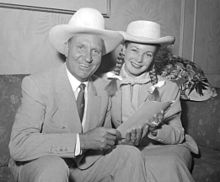
Gene Autry and Gail Davis |
Retirement
Autry retired from show business in 1964, having made
almost 100 films up to 1955 and over 600 records. He was elected to the
Country Music Hall of Fame in 1969 and to the Nashville Songwriters Hall
of Fame in 1970. After retiring, he invested widely and in real estate,
radio, and television, including the purchase from dying Republic Pictures
the rights for films he had made for the company.
In 1952 Autry bought the old Monogram Ranch in Placerita
Canyon (Newhall-Santa Clarita, California,) and renamed it Melody Ranch.
Numerous "B" Westerns and TV shows were shot there during Autry's ownership,
including the initial years of Gunsmoke with James Arness. Melody Ranch
burned down in 1962, dashing Autry's plans to turn it into a museum. According
to a published story by Autry the fire caused him to turn his attention
to Griffith Park, where he would build his Museum of Western Heritage (now
known as the Autry National Center). Melody Ranch came back to life after
1991, when it was purchased by the Veluzat family and rebuilt. It survives
as a movie location today as well as the home of the City of Santa Clarita's
annual Cowboy Festival, where Autry's legacy takes center stage.
Baseball
In the 1950s Autry had been a minority owner of the minor-league
Hollywood Stars. In 1960, when Major League Baseball announced plans to
add an expansion team in Los Angeles, Autry—who had once declined an opportunity
to play in the minor leagues—expressed an interest in acquiring the radio
broadcast rights to the team's games. Baseball executives were so impressed
by his approach that he was persuaded to become the owner of the franchise
rather than simply its broadcast partner. The team, initially called the
Los Angeles Angels upon its 1961 debut, moved to suburban Anaheim in 1966,
and was renamed the California Angels, then the Anaheim Angels from 1997
until 2005, when it became the Los Angeles Angels of Anaheim. Autry served
as vice president of the American League from 1983 until his death. In
1995 he sold a quarter share of the team to The Walt Disney Company and
a controlling interest the following year, with the remaining share to
be transferred after his death. Earlier, in 1982, he sold Los Angeles television
station KTLA for $245 million.[citation needed] He also sold several radio
stations he owned, including KSFO in San Francisco, KMPC in Los Angeles,
KOGO in San Diego, and other stations in the Golden West radio network.
The number 26 (as in 26th man) was retired by the Angels
in Autry's honor. The chosen number reflected that baseball's rosters are
25-man strong, so Autry's unflagging support for his team made him the
26th member.
Death
Included for many years on Forbes magazine's list of the
400 richest Americans, he slipped to their "near miss" category in 1995
with an estimated net worth of $320 million. Gene Autry died of lymphoma
3 days after his 91st birthday at his home in Studio City, California and
is interred in the Forest Lawn, Hollywood Hills Cemetery in Los Angeles,
California. His death on October 2, 1998 came fewer than three months after
the death of another celebrated cowboy of the silver screen, radio, and
TV, Roy Rogers.
Personal life
In 1932 he married Ina May Spivey (who died in 1980),
who was the niece of Jimmy Long. In 1981 he married Jacqueline Ellam, who
had been his banker. He had no children by either marriage.
Autry, was raised into Freemasonry in 1927 at Catoosa
Lodge No. 185, Catoosa Oklahoma. He later became a 33rd degree Master Mason,
as recorded on his headstone.
Legacy
| On November 16, 1941, the town of Berwyn, Oklahoma, north
of Ardmore, was renamed in honor of Gene Autry.
In 1972 he was inducted into the Western Performers Hall
of Fame at the National Cowboy & Western Heritage Museum in Oklahoma
City, Oklahoma. Autry was a life member of the Benevolent and Protective
Order of Elks, Burbank Lodge No. 1497. His 1976 autobiography, co-written
by Mickey Herskowitz, was titled Back in the Saddle Again after his 1939
hit and signature tune. He is also featured year after year, on radio and
"shopping mall music" at the holiday season, by his recording of "Rudolph,
the Red-Nosed Reindeer." "Rudolph" became the first No. 1 hit of the 1950s.
CMT in 2003 ranked him No. 38 in CMT's 40 Greatest Men of Country Music.
When the Anaheim Angels won their first World Series in
2002, much of the championship was dedicated to him. The interchange of
Interstate 5 and State Route 134, located near the Autry National Center
in Los Angeles, is signed as the "Gene Autry Memorial Interchange." In
2007, he became a charter member of the Gennett Records Walk of Fame in
Richmond, Indiana.
Johnny Cash recorded a song in 1978 about Autry called
"Who is Gene Autry?" Cash also got Autry to sign his famous black Martin
D-35 guitar, which he plays in the video of "Hurt."
|
.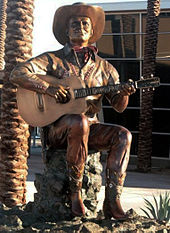
Gene Autry statue in
Palm Springs, California |
Autry was inducted into the Radio Hall of Fame in 2003. In
2004, the Starz Entertainment Corporation joined forces with the Autry
estate to restore all of his films, which have been shown on Starz's Encore
Western Channel on cable television on a regular basis to date since.
Autry was inducted into the [Oklahoma Hall of Fame] in
1991.
Hollywood Walk of Fame
Autry is the only person to have five stars on the Hollywood
Walk of Fame, one in each of the five categories maintained by the Hollywood
Chamber of Commerce.
Motion pictures, located at 6644 Hollywood
Blvd.
Radio, located at 6520 Hollywood Blvd.
Recording, located at 6384 Hollywood
Blvd.
Television, located at 6667 Hollywood
Blvd.
Live theater, located at 7000 Hollywood
Blvd.
The Museum of the American West
The Museum of the American West in Los Angeles' Griffith
Park was founded in 1988 as the Gene Autry Western Heritage Museum, featuring
much of his collection of Western art and memorabilia. It is now called
The Autry National Center and is divided into two locations, eight miles
apart from each other. Its mission is to present the unique and diverse
perspectives of the American West, including the romanticized West in pop
culture and the "real" nuanced history, including native and minority voices.
|
.
All articles submitted to the "Brimstone
Gazette" are the property of the author, used with their expressed permission.
The Brimstone Pistoleros are not
responsible for any accidents which may occur from use of loading
data, firearms information, or recommendations published on the Brimstone
Pistoleros web site. |
|